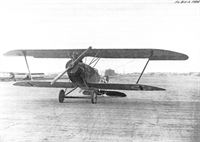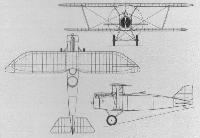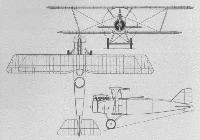
Описание
Страна: Германия
Год: 1918
Fighter
O.Thetford, P.Gray German Aircraft of the First World War (Putnam)
B.F.W. CL I
Designed to CL specification as an improvement on the Halberstadt CL II, but remained only a prototype. Engine, 160 h.p. Mercedes D III.
B.F.W. CL II
Development of B.F.W. CL I. Prototype only. Engine, 175 h.p. MAN III. Test flown July 1918.
B.F.W. CL III
Final aircraft in B.F.W. CL series. Remained prototype only. Engine, 200 h.p. Benz Bz IV.
Описание:
- O.Thetford, P.Gray German Aircraft of the First World War (Putnam)
- W.Green, G.Swanborough The Complete Book of Fighters
- J.Herris Otto, AGO and BFW Aircraft of WWI (A Centennial Perspective on Great War Airplanes 37)
Фотографии
-
J.Herris - Otto, AGO and BFW Aircraft of WWI /Centennial Perspective/ (37)
BFW CL.I prototype powered by a 160 hp Mercedes D.III engine. (Peter M. Grosz Collection/STDB)
Built in 1918, the CL I (Type 17) recce-fighter was the first military aircraft by BFW. -
J.Herris - Otto, AGO and BFW Aircraft of WWI /Centennial Perspective/ (37)
The delicate look of the struts on the BFW CL.I prototype indicates it may not have been sturdy enough for the demanding two-seat fighter role of CL-type aircraft. (Peter M. Grosz Collection/STDB)
-
J.Herris - Otto, AGO and BFW Aircraft of WWI /Centennial Perspective/ (37)
The BFW CL.I and CL.II appear to have used the same airframe design. (Peter M. Grosz Collection/STDB)
-
J.Herris - Otto, AGO and BFW Aircraft of WWI /Centennial Perspective/ (37)
The Bayerische Flugzeugwerke developed three BFW CL aircraft. The BFW CL.II was used to test the Mana III in July 1918.
-
J.Herris - Otto, AGO and BFW Aircraft of WWI /Centennial Perspective/ (37)
The BFW CL.II was built in July 1918 and was powered by the 185 hp Mana III engine. The BFW CL.I, CL.II, and CL.III appear to have used the same airframe with the difference being the engine used. The CL.I had a 160 hp Mercedes and the CL.III had a 200 hp Benz Bz IV, all using an annular radiator.
-
J.Herris - Otto, AGO and BFW Aircraft of WWI /Centennial Perspective/ (37)
BFW CL.III prototype powered by a 200 hp Benz Bz.IV engine. Two-seaters with that engine were normally classified as C-types. (Peter M. Grosz Collection/STDB)
-
O.Thetford, P.Gray - German Aircraft of the First World War /Putnam/
B.F.W. CL III
A Germania Single-Strut Biplane of the "C" Class, with a curious circular-shaped radiator. -
M.Dusing - German Aviation Industry in WWI. Volume 1 /Centennial Perspective/ (84)
Evolved from the Cl I, the BFW Cl III featured longer-span wings and a Benz Bz IV engine.
-
J.Herris - Otto, AGO and BFW Aircraft of WWI /Centennial Perspective/ (37)
The BFW CL.I, CL.II, and CL.III all appear to have the same airframe. (Peter M. Grosz Collection/STDB)
-
W.Green, G.Swanborough - The Complete Book of Fighters
The second prototype of the BFW Cl I became the Cl II with a MAN III engine.
-
W.Green, G.Swanborough - The Complete Book of Fighters
The BFW Cl III was too late for wartime service.













